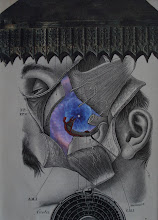


On Wednesday of this week, I went to see the Scwitters exhibit at the Princeton University art museum. WOW! Awesome! Every individual interested in collage should see this show. These are three pieces which were in the exhibit. They were sold out of the catalog (but I am on the list!). The good news is that this is a GREAT show of Schwitters' works (which are rarely shown together). The bad news is that it is only up until June 26th. If by chance, you can see the show... SEE IT! So what's the other good news? The show will be moving to Berkeley CA for West coast fans. AND... I will post more photos once I get the exhibition catalog! Here is an excerpt from the NYT review of the show:
"Schwitters made no categorical distinctions between his art (painting, collage, sculpture, design, installation), his writing (poetry, essays, children’s stories) and his performances. To him they were all integral parts of a one-man cultural movement called Merz, which he invented, deriving the name from Kommerz, German for commerce.
The multidisciplinary nature of Schwitters’s output, which can make a career survey look like a group show, may be one of the reasons he remains an underknown figure. His sole American retrospective, at MoMA, was 25 years ago. Representative samplings of his art have since rarely been on view, there or elsewhere.
Yet he has had a huge effect on post-World War II artists and is revered by many. Two of the collages in the Princeton show are from Jasper Johns’s collection; two others are owned by Ellsworth Kelly. Robert Rauschenberg, who introduced Mr. Johns to Schwitters’s work, was a major fan. And a Schwitters effect, however indirect and unrecognized, can be spotted in much contemporary work.
Even in his own time he was hard to get to know. He made contradictory impressions on people who encountered him. To those who knew him through his performances he was an extrovert: a large, hammy guy with big ideas and a big voice, relishing the role of clown.
But he could quickly drop into loner mode, shy away from company, rebuff unsought friendship, assert the middle-class proprieties he grew up with. After bouts of what seemed like compulsive extroversion, he spent long stretches on his own. And the dozens of collages and assemblages at Princeton suggest how he used that time.
Meticulously puzzled together from paper, fabric, wire, scrap wood and other everyday materials, these pieces are the work of a sorter and measurer, a concentrator, a tabletop worker, someone who found satisfaction — more than that, comfort — in up-close, fine-grained aesthetic control. Even the Merzbau, with its interior network of nooks and shelves, projected deep focus, on a walk-in scale."









No comments:
Post a Comment